
The Centennial International Exhibition, officially the International Exhibition of Arts, Manufactures, and Products of the Soil and Mine, was held in Philadelphia from May 10 to November 10, 1876. It was the first official world's fair to be held in the United States, and coincided with the centennial anniversary of the Declaration of Independence's adoption in Philadelphia on July 4, 1776.

The Liberty Bell, previously called the State House Bell or Old State House Bell, is an iconic symbol of American independence located in Philadelphia. Originally placed in the steeple of Pennsylvania State House, now known as Independence Hall, the Liberty Bell today is located across the street from Independence Hall in the Liberty Bell Center in Independence National Historical Park.
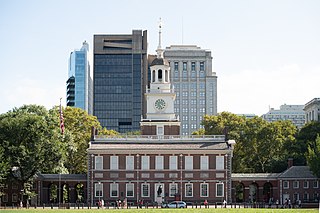
Independence Hall is a historic civic building in Philadelphia, where both the United States Declaration of Independence and the United States Constitution were debated and adopted by America's Founding Fathers. The structure forms the centerpiece of the Independence National Historical Park. Independence Hall was named to the National Register of Historic Places in 1966 and as a World Heritage Site in 1979.

The National Constitution Center is a non-profit institution that is devoted to the study of the Constitution of the United States. Located at the Independence Mall in Philadelphia, Pennsylvania, the center is an interactive museum which serves as a national town hall, hosting government leaders, journalists, scholars, and celebrities who engage in public discussions, including Constitution-related events and presidential debates.
Romaldo "Aldo" Giurgola AO was an Italian academic, architect, professor, and author. Giurgola was born in Rome, Italy in 1920. After service in the Italian armed forces during World War II, he was educated at the Sapienza University of Rome. He studied architecture at the University of Rome, completing the equivalent of a B.Arch. with honors in 1949. That same year, he moved to the United States and received a master's degree in architecture from Columbia University. In 1954, Giurgola accepted a position as an assistant professor of architecture at the University of Pennsylvania. Shortly thereafter, Giurgola formed Mitchell/Giurgola Architects in Philadelphia with Ehrman B. Mitchell in 1958. In 1966, Giurgola became chair of the Columbia University School of Architecture and Planning in New York City, where he opened a second office of the firm. In 1980 under Giurgola's direction, the firm won an international competition to design a new Australian parliament building. Giurgola moved to Canberra, Australia to oversee the project. In 1989, after its completion and official opening in 1988, the Parliament House was recognised with the top award for public architecture in Australia.
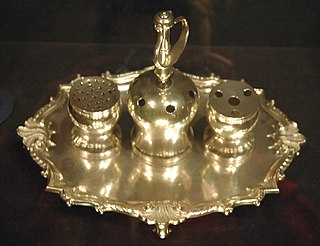
The Syng inkstand is a silver inkstand used during the signing of the United States Declaration of Independence in 1776 and the United States Constitution in 1787. Besides paper documents, it is one of four still-existing objects that were present during the Constitutional Convention, along with the Liberty Bell, the chair that George Washington sat in as the Constitutional Convention's presiding officer, and Independence Hall itself.

Independence National Historical Park is a federally protected historic district in Philadelphia, Pennsylvania that preserves several sites associated with the American Revolution and the nation's founding history. Administered by the National Park Service, the 55-acre (22 ha) park comprises many of Philadelphia's most-visited historic sites within the Old City and Society Hill neighborhoods. The park has been nicknamed "America's most historic square mile" because of its abundance of historic landmarks.

Philadelphia Mills is an enclosed shopping mall in Northeast Philadelphia, bordering Bensalem in Bucks County and 15 miles (24 km) from Center City. Formerly named for Benjamin Franklin, the mall is home to 125 stores, a movie theatre, a food court, and seven theme restaurants and was visited by an estimated 18 million people in 2006. The anchor stores are Dave & Buster's, Forever 21, Urban Planet, Saks Fifth Avenue, Marshalls, HomeGoods, American Freight, Walmart, AMC Theatres, Burlington, and Turn 7 Liquidators. Two currently vacant anchor stores once housed Phar-Mor and Modell's Sporting Goods.
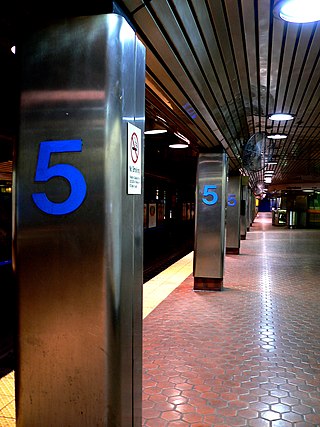
5th Street/Independence Hall station is a subway station in Philadelphia, Pennsylvania at the intersection of 5th and Market Street served by SEPTA's Market-Frankford Line. The station serves multiple notable Philadelphia landmarks including Independence Hall, the Liberty Bell, the National Constitution Center, the National Museum of American Jewish History, and the Philadelphia Bourse.
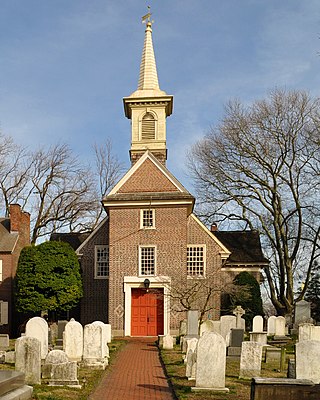
The architecture of Philadelphia is a mix of historic and modern styles that reflect the city's history. The first European settlements appeared within the present day borders of Philadelphia, Pennsylvania in the 17th century with most structures being built from logs. By the 18th century, brick structures had become common. Georgian and later Federal style buildings dominated much of the cityscape. In the first half of the 19th century, Greek revival appeared and flourished with architects such as William Strickland, John Haviland, and Thomas U. Walter. In the second half of the 19th century, Victorian architecture became popular with the city's most notable Victorian architect being Frank Furness.

Liberty Place is a skyscraper complex in Philadelphia. The complex is composed of a 61-story, 945-foot (288 m) skyscraper called One Liberty Place, a 58-story, 848-foot (258 m) skyscraper called Two Liberty Place, a two-story shopping mall called the Shops at Liberty Place, and the 14-story Westin Philadelphia Hotel.
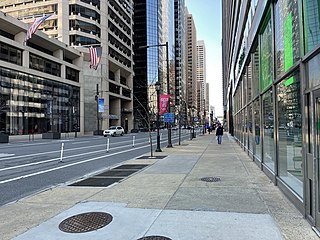
Market Street, originally known as High Street, is a major east–west highway and street in Philadelphia, Pennsylvania, United States. The street is signed as Pennsylvania Route 3 between 38th Street and 15th Street. A short portion of the road continues west from Cobbs Creek Parkway to Delaware County, adjacent to Philadelphia. The street also serves as the dividing line for the "north" and "south" sides of the city. All north-south addresses in the city start at zero at Market Street.
Jacques-Henri-Auguste Gréber was a French architect specializing in landscape architecture and urban design. He was a strong proponent of the Beaux-Arts style and a contributor to the City Beautiful movement, particularly in Philadelphia and Ottawa.

Edmund Woolley (c.1695—1771) was an English-born American architect and master carpenter, best known for building Independence Hall in Philadelphia, Pennsylvania, United States.

The President's House in Philadelphia was the third U.S. Presidential Mansion. George Washington occupied it from November 27, 1790, to March 10, 1797, and John Adams occupied it from March 21, 1797, to May 30, 1800.

The Provident Life & Trust Company is a demolished Victorian-era building in Philadelphia designed by architect Frank Furness and considered to be one of the famed architect's greatest works. A bank and insurance company founded in 1865 by members of the Society of Friends (Quakers), the Provident's L-shaped building had entrances at 407–09 Chestnut Street, which served as the entrance to the bank, and at 42 South 4th Street, which was the entrance to the insurance company. The two wings were eventually consolidated into an office building, also designed by Furness, at the northwest corner of 4th and Chestnut Streets.
Stuart Franklin Feldman was an American lobbyist and social activist who worked in the administrations of John F. Kennedy, Lyndon B. Johnson and Richard Nixon. He co-founded in 1978 what became Vietnam Veterans of America together with Bobby Muller. Feldman was a longtime advocate for greater awareness of the needs of veterans and seeing to it that they were provided with better education, health care and job opportunities.

Samuel Harding was an American cabinetmaker, remembered for his Queen Anne style furniture and for the interior architectural ornament of Independence Hall, in Philadelphia, Pennsylvania, United States.

The Justice Bell is a replica of the Liberty Bell made in 1915. It was created to promote the cause for women's suffrage in the United States from 1915 to 1920. The bell is on permanent display at the Washington Memorial Chapel in Valley Forge National Park in Pennsylvania.

Independence Hall replicas are buildings, models and miniatures replicating or inspired by the design of Independence Hall in Philadelphia, Pennsylvania, United States.






















